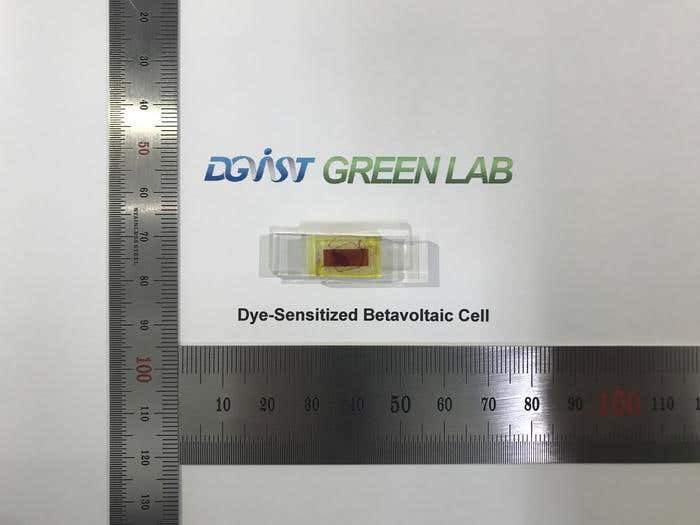Tiny nuclear battery could run for decades without charging
A new nuclear battery powered by radiocarbon offers safe, long-lasting energy for devices—from implants to satellites—without recharging.

“A compact dye-sensitized betavoltaic cell incorporates radiocarbon at both the anode and cathode, significantly enhancing its energy conversion efficiency. (CREDIT: Su-Il In)
A battery that lasts not weeks or months, but decades, may soon be more than just a dream. While rechargeable lithium-ion batteries power phones, laptops, drones, and electric cars, they all share a flaw—they wear out fast and need frequent charging. Over time, this inconvenience grows into a major problem. As these batteries degrade, they become unreliable, costly to replace, and harmful to the environment.
That’s why a new kind of battery is turning heads in the world of science. It runs not on lithium, but on a small amount of radioactive carbon. Unlike traditional nuclear energy, this battery stays safe, compact, and clean—and it could power devices for generations without needing a recharge.
A Tiny Battery with Big Potential
Researchers have built a nuclear battery that runs on radiocarbon, a radioactive form of carbon also known as carbon-14. This type of carbon emits only beta particles—high-energy electrons that can be safely blocked by thin shielding, like aluminum foil. It’s not the scary kind of nuclear radiation that harms people.
Radiocarbon is also cheap and easy to get. It’s a by-product of nuclear power plants, so it’s already being made. Because it decays slowly, it can provide steady energy for thousands of years.
“We can put safe nuclear energy into devices the size of a finger,” says Su-Il In, a professor who led the development of this battery. He and his team presented their work at the Spring 2025 meeting of the American Chemical Society, where nearly 12,000 scientists gathered to share the latest research.
The most exciting part? This new kind of battery could change how we power everything from satellites to medical implants. It could make pacemakers that last a lifetime, or sensors deep in forests or oceans that never need a new battery.
How It Works
Most batteries store chemical energy and convert it into electricity. But a betavoltaic battery does something different. It uses energy from radioactive decay.
Related Stories
As carbon-14 breaks down, it gives off beta rays. When these beta particles strike a semiconductor—a special type of material that can carry electric current—they kick off a chain reaction. This leads to the release of electrons that flow into a circuit, creating electricity.
That’s the basic idea behind a betavoltaic cell. But In’s team found a way to make this process far more efficient. Instead of letting the beta particles hit the semiconductor directly, they first hit a special dye made from a metal called ruthenium. This dye absorbs the energy better than the semiconductor alone.
The dye is coated onto titanium dioxide, a common material used in solar panels. When the dye absorbs a beta particle, it triggers an “electron avalanche.” The electrons move quickly through the dye and into the titanium dioxide, which collects them and sends them through a circuit.
The result is a strong, steady flow of electricity from a very small source of radiation.
A Major Leap in Efficiency
Earlier designs placed the radioactive carbon only on one side of the battery—the cathode. That version could turn just 0.48% of the radioactive energy into electricity. But In’s team made a clever upgrade.
They added radiocarbon to both the anode and the cathode. This dual-site design allowed the battery to catch more beta rays and reduced the energy lost between the two ends of the cell. The new design boosted efficiency to 2.86% and delivered a power density of 20.75 nanowatts per square centimeter per millicurie of radiation. That might sound small, but in the world of long-lasting, low-power devices, it’s a breakthrough.
The researchers also treated the titanium dioxide with citric acid to form stronger bonds with the ruthenium dye. This increased the stability and helped create more efficient energy transfer. These changes together led to better overall performance.
“We decided to use a radioactive isotope of carbon because it generates only beta rays,” says In. “It’s inexpensive, safe, and easy to recycle.”
Why Lithium Isn’t Enough
Lithium-ion batteries may power most of today’s portable devices, but they come with real drawbacks. Mining lithium uses huge amounts of energy and water. Improper disposal pollutes soil and water with toxic metals. And from an engineering standpoint, Li-ion batteries have almost reached their limits.
“The performance of Li-ion batteries is almost saturated,” In explains. That means they’re unlikely to improve much in the future. As more devices connect to the internet and rely on remote sensors and computing, the world needs a new kind of battery—one that lasts longer and works where regular batteries fail.
Nuclear batteries like the one In developed don’t need to be recharged. They don’t degrade over time. And they can be made small enough to power delicate devices like brain implants or precision instruments in space.
What’s Next for Nuclear Batteries?
The latest design marks a big step forward, but it’s not perfect. Even at 2.86% efficiency, the battery converts only a small fraction of decay energy into electricity. That’s far below the efficiency of conventional batteries.
To improve it, In and his team plan to optimize the shape of the radiocarbon emitters. They also aim to create better materials that absorb beta particles more effectively. With those advances, the power output could increase—and so could the number of practical uses.
The public is also beginning to see nuclear energy in a new light. As concern about climate change grows, many people now understand that nuclear energy can be clean and safe. Betavoltaic batteries don’t use the same dangerous fuel found in reactors, and they can’t cause meltdowns.
Instead, they offer a quiet, reliable source of power for the future. Whether it’s in a drone, a deep-space probe, or a heart monitor, this new kind of battery could help us live more connected lives—with fewer interruptions and much less waste.
Note: The article above provided above by The Brighter Side of News.
Like these kind of feel good stories? Get The Brighter Side of News' newsletter.



